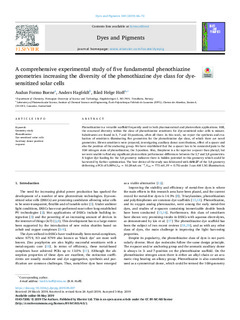A comprehensive experimental study of five fundamental phenothiazine geometries increasing the diversity of the phenothiazine dye class for dye-sensitized solar cells
| dc.contributor.author | Buene, Audun Formo | |
| dc.contributor.author | Hagfeldt, Anders | |
| dc.contributor.author | Hoff, Bård Helge | |
| dc.date.accessioned | 2020-01-08T14:25:56Z | |
| dc.date.available | 2020-01-08T14:25:56Z | |
| dc.date.created | 2019-05-31T18:43:47Z | |
| dc.date.issued | 2019 | |
| dc.identifier.citation | Dyes and pigments. 2019, 169 66-72. | nb_NO |
| dc.identifier.issn | 0143-7208 | |
| dc.identifier.uri | http://hdl.handle.net/11250/2635404 | |
| dc.description.abstract | Phenothiazine is a versatile scaffold frequently used in both pharmaceutical and photovoltaic applications. Still, the structural diversity within the class of phenothiazine sensitizers for dye-sensitized solar cells is minute. Substituents are found in 3, 7 and 10-positions, often all three. In this work, we report the synthesis and evaluation of sensitizers illuminating five geometries for the phenothiazine dye class, of which three are novel geometries. Eleven sensitizers were prepared, investigating auxiliary donor contributions, effect of π-spacer and also the position of the anchoring group. We have established that the π-spacer has to be connected para to the 10H nitrogen atom of phenothiazine, the 3-position. Also, thiophene is a far superior π-spacer than phenyl, but we were unable to find any significant photovoltaic performance differences between the 3,7 and 3,8 geometries. A higher dye loading for the 3,8 geometry indicates there is hidden potential in this geometry which could be harvested by further optimization. The best device of the study was fabricated with AFB-27 of the 3,8 geometry delivering a PCE of 5.88% (JSC = 10.28 mA cm−2, VOC = 773 mV, FF = 0.75) under 1 sun AM 1.5G illumination. | nb_NO |
| dc.language.iso | eng | nb_NO |
| dc.publisher | Elsevier | nb_NO |
| dc.rights | Attribution-NonCommercial-NoDerivatives 4.0 Internasjonal | * |
| dc.rights.uri | http://creativecommons.org/licenses/by-nc-nd/4.0/deed.no | * |
| dc.title | A comprehensive experimental study of five fundamental phenothiazine geometries increasing the diversity of the phenothiazine dye class for dye-sensitized solar cells | nb_NO |
| dc.type | Journal article | nb_NO |
| dc.type | Peer reviewed | nb_NO |
| dc.description.version | publishedVersion | nb_NO |
| dc.source.pagenumber | 66-72 | nb_NO |
| dc.source.volume | 169 | nb_NO |
| dc.source.journal | Dyes and pigments | nb_NO |
| dc.identifier.doi | 10.1016/j.dyepig.2019.05.007 | |
| dc.identifier.cristin | 1701970 | |
| dc.description.localcode | Copyright 2019 The Authors. Published by Elsevier Ltd. This is an open access article under the CC BY-NC-ND license (http://creativecommons.org/licenses/BY-NC-ND/4.0/). | nb_NO |
| cristin.unitcode | 194,66,25,0 | |
| cristin.unitname | Institutt for kjemi | |
| cristin.ispublished | true | |
| cristin.fulltext | original | |
| cristin.qualitycode | 1 |
Tilhørende fil(er)
Denne innførselen finnes i følgende samling(er)
-
Institutt for kjemi [1352]
-
Publikasjoner fra CRIStin - NTNU [37175]

